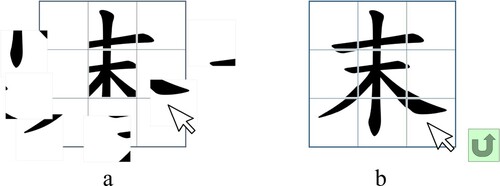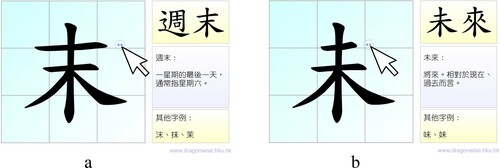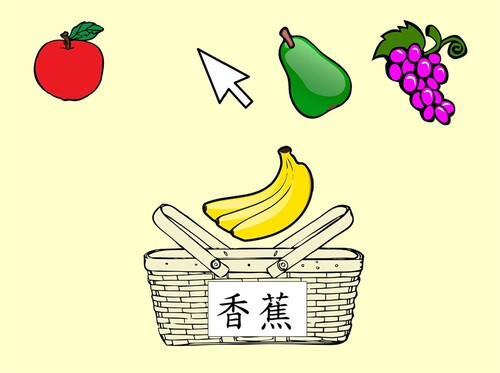Figures & data
Figure 1. Multiple-choice exercise (Original). (a) Learners are asked to fill in a missing character to complete the sentence 週_去哪裡玩? “Where do you go on the week___?” Three options 沒 “do not”, 末 “end”, and 未 “not yet” are provided. (b) When the learners click on the correct answer 末 “end”, the sentence will be completed with the word 週末 “weekends”. The learners will be given a tick mark with applause. (c) Otherwise, when the learners click on the incorrect options 沒 “do not”, or 未 “not yet”, which cannot be combined with 週 “week” to form a word in Chinese, the learners will be given a cross mark with a “wrong answer” sound effect.

Figure 2. Multiple-choice exercise (Revised). When the learners choose different incorrect options 沒 “do not” or 未 “not yet”, different feedback will be provided. (a) When the learners click on the incorrect option 沒 “do not” /mut6/, which has the same sound as the correct answer 末 /mut6/ but cannot be combined with 週 “week” to form a word, the learners probably do not realize the difference between the situations in which the two characters 沒 and 末 are used. Thus, the program will offer the feedback that 沒 is used in words like 沒有 “have not”; while 末 is used in the word 週末 “weekends”. (b) When the learners click on the incorrect option 未 “not yet”, they probably do not realize the difference in the relative length of the two horizontal strokes of the two characters 未 and 末 “end” (the correct answer). Thus, the program will show slanting lines to highlight the relative length of the two horizontal strokes in the two characters to the learners. Moreover, it is also possible for the learners to explore the difference in sounds and situations in which the two characters are used by the provision of the word examples in red.

Figure 3. Jigsaw Puzzle. (a & b) Learners are asked to put the pieces of a jigsaw puzzle together to form the character 末 “end”. The learners can drag and drop the pieces anywhere. When a piece is placed at its correct position, it will be fixed with a “click” sound. When the piece is placed at any other position, no feedback will be given.

Figure 4. Direct exploration. Learners are asked to explore the difference between the characters 末 “end” and 未 “not yet”. (a) At the beginning, the character 末 is shown. The learners can drag either ends of the upper horizontal stroke left or right to change its length. (b) When the horizontal stroke is shortened, the character will become 未 and its sound /mei6/ will be pronounced. Explanations about the usage of the character such as 未來 “future” will also be provided. (a) When the horizontal stroke is lengthened, the character will change back to 末 and its sound /mut6/ and explanations will be offered.

Figure 5. Drag and drop (Original). (a) Learners are asked to choose one of the four pictures of fruit that matches the word printed on the basket (i.e. 香蕉 “banana”). (b) The learners can drag and drop the four pictures. When the learners put a picture in a place other than the basket, the picture will bounce back to its original location. When the correct picture (i.e. banana) is dropped into the basket, the learners have successfully completed the task. (c) When the learners repeatedly drop an incorrect option (e.g. apple or pear) into the basket, the learners will be sent to explore again the Chinese words and the pronunciations of the four pictures of fruit.


